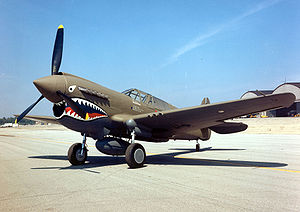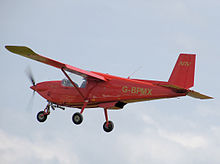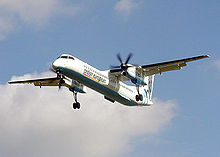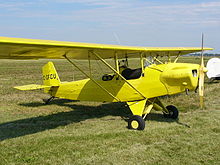- Monoplane
-
- For Félix du Temple's invention, see Monoplane (1874)
Monoplane 
The low-wing of a Curtiss P-40  The mid-wing of a de Havilland Vampire T11.
The mid-wing of a de Havilland Vampire T11.
 The shoulder-wing of an ARV Super2.
The shoulder-wing of an ARV Super2.
 Félix du Temple's 1874 Monoplane.
Félix du Temple's 1874 Monoplane.
A monoplane is a fixed-wing aircraft with one main set of wing surfaces, in contrast to a biplane or triplane. Since the late 1930s it has been the most common form for a fixed wing aircraft.
Contents
Types of monoplane
The main distinction between types of monoplane is where the wings attach to the fuselage:
- low-wing, the wing lower surface is level with (or below) the bottom of the fuselage
- mid-wing, the wing is mounted mid-way up the fuselage
- shoulder wing, the wing is mounted above the fuselage middle
- high-wing, the wing upper surface is level with or above the top of the fuselage
- parasol-wing, the wing is located above the fuselage and is not directly connected to it, structural support being typically provided by a system of struts, and, especially in the case of older aircraft, wire bracing.
History
Most of the first attempts of heavier-than-air flying machines were monoplanes. Notably, the Monoplane built in 1874 by Felix du Temple de la Croix, a large aircraft made of aluminium with a wingspan of 13 m (42.7 ft) and a weight of only 80 kg (176 lb) (without the pilot). Several trials were made with the plane in Brest, France, and it is generally recognized that it achieved lift off under its own power after a ski-jump run, glided for a short time and returned safely to the ground, possibly making it the first successful powered flight in history, depending on the definition — since the flight was only a few feet high, and was not truly under control.
Other early attempts of flight by a monoplane were carried out in 1884 by Alexander Mozhaysky.[1]
The first successful aircraft were biplanes, but many pioneering aircraft were monoplanes, for instance Blériot XI that flew across the English Channel in 1909. Throughout 1909-1910 Hubert Latham set multiple altitude records in his Antoinette IV monoplane, initially achieving 155 m (509 ft) then raising it to 1,384 m (4,541 ft).[2] The Fokker Eindecker of 1915 was a successful fighter aircraft. The Junkers J 1 was an early German "technology demonstrator" monoplane, and the world's very first practical all-metal aircraft of any type to fly, with the J 1's first flight occurring in December 1915.
Nonetheless, relatively few monoplane types were built between 1914, and the late 1920s, compared with the number of biplanes. The reasons for this were primarily structural. In the days when wings (whether biplane or monoplane) were thin, lightly built structures, braced by struts, steel wire or cables - the biplane wing formed a strong and fairly rigid lattice truss structure, in which the two wing surfaces were braced against each other. Early monoplane wings, on the other hand, tended to be liable to twist under aerodynamic loads, rendering proper lateral control very difficult. They were also much more liable to breakage in flight.
Once all-metal construction and the cantilever wing, both having been pioneered by Hugo Junkers in 1915, became common after World War I's end, however, the day of the biplane very quickly passed, and the monoplane became the usual configuration for a fixed-wing aircraft. Most military aircraft of WW2 were monoplanes, as have been virtually all aircraft since.
See also
References
- ^ Gray, Carroll (undated). "Aleksandr Fyodorovich Mozhaiski". http://www.flyingmachines.org/moz.html. Retrieved 8 November 2011.
- ^ King, Windkiller, p. 227.
Lists relating to aviation General Aircraft (manufacturers) · Aircraft engines (manufacturers) · Airlines (defunct) · Airports · Civil authorities · Museums · Registration prefixes · Rotorcraft (manufacturers) · TimelineMilitary Accidents/incidents Records Categories:- Wing configurations
Wikimedia Foundation. 2010.



